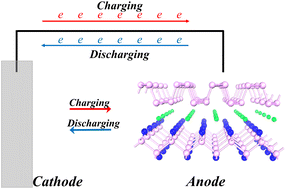Black phosphorene/NP heterostructure as a novel anode material for Li/Na-ion batteries†
Abstract
Designing heterostructured anode materials has been rendered supremely appealing to large-scale energy storage systems and storage device researchers. Recently, black phosphorene has experienced explosive development and been sought for widespread application in various domains including anode materials for electrochemistry. Hence, in this work, the black phosphorene/NP heterostructure (black P/NP) as a novel anode material for Li/Na batteries was systematically studied on the basis of first-principle calculations. Our simulations disclose that black P/NP is dynamically stable at room temperature and exhibits metallic properties. Charge density difference calculations and work function analysis demonstrate that electron charge transfer between the pristine single-layer components leads to enhanced Li/Na ion adsorption on the interlayer. To be specific, the calculated adsorption energies for Li/Na are −2.27 and −2.13 eV, respectively, which are sufficient to prevent metal aggregation during cycling. Besides, it is predicated that black P/NP has a positive and low open-circuit voltage. Excitingly, the diffusion barriers for Li and Na ions on black P/NP are 0.17 and 0.04 eV, respectively, which are superior to other typical heterostructures. Our results may be a new paradigm and reference for phosphorene-based heterostructures used as electrode materials of metal-ion batteries.



 Please wait while we load your content...
Please wait while we load your content...